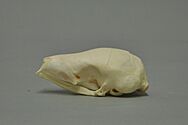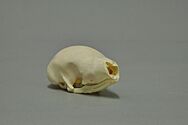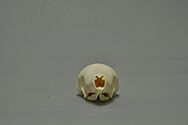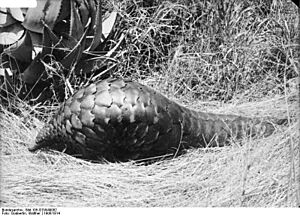Ground pangolin facts for kids
Quick facts for kids Ground pangolin |
|
|---|---|
 |
|
|
|
|
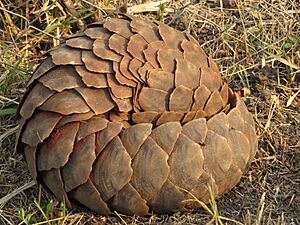 |
|
|
|
|
| Conservation status | |
| Scientific classification | |
| Genus: |
Smutsia
|
| Species: |
temminckii
|
 |
|
| Ground pangolin range | |
| Synonyms | |
|
synonyms of species:
Manis temminckii (Smuts, 1832)
Phatages hedenborgii (Fitzinger, 1872) Phataginus temminckii |
|
The ground pangolin (Smutsia temminckii), also known as Temminck's pangolin or Cape pangolin, is a unique animal found in Africa. It's one of four pangolin species living on the continent, and the only one found in southern and eastern Africa. This amazing creature was named after a Dutch zoologist, Coenraad Jacob Temminck.
Contents
Physical Features of the Ground Pangolin
Pangolins are almost completely covered in tough, overlapping scales. These scales make up about 20% of their body weight. The scales are made of keratin, which is the same material as your hair and fingernails. This gives pangolins a look similar to a pinecone or an artichoke.
The underside of a pangolin doesn't have scales; instead, it has a bit of fur. When a pangolin feels scared, it usually rolls up into a tight ball. This protects its soft, vulnerable belly from danger.
Size and Appearance
Pangolins can be 30 to 90 centimeters (1 to 3 feet) long, not counting their tails. They weigh from 5 to 27 kilograms (10 to 60 pounds). Their tails can be about 26 to 70 centimeters (10 to 28 inches) long. Adult pangolins are light brown, olive, or dark brown. Young pangolins are usually pale brown or pink.
Unique Body Parts
Ground pangolins often walk on their back legs. They sometimes use their front legs and tail to help them balance. Their limbs are perfect for digging. They have five toes on each foot, and their front feet have three long, curved claws. These claws are great for breaking into termite nests and digging burrows. Because of these long claws, pangolins have to walk on the outer edges of their front feet. They tuck in their claws to keep them safe.
Pangolins have long, wide tails and small, cone-shaped heads. They don't have any teeth! Instead of chewing, their stomach is very muscular. It has spiny parts inside and contains small stones, like a bird's gizzard. These stones help mash and grind their food.
Pangolins also have very long, muscular tongues. They use their tongues to reach into holes and slurp up ants and termites. Their tongues can stretch so far that they are actually longer than their entire body! The tongue is attached deep inside their body, near their pelvis, and can pull back into their chest. Pangolins have small ears, so their hearing isn't great. Their eyesight is also poor, but they have a very strong sense of smell.
Where Ground Pangolins Live
African pangolin species live in 15 different African countries. These countries are spread across southern, central, and east Africa. The ground pangolin (S. temminckii) is the only species found in southern and eastern Africa. It likes to live in savannah woodlands with some bushes, usually in lower areas.
Ground Pangolin Behavior
We don't know a lot about pangolins because they are hard to study in the wild. Pangolins are solitary animals, meaning they live alone. They only meet up to mate. They dig deep burrows with round chambers to live in. These burrows can even be big enough for a human to crawl into and stand up!
Even though they can dig their own homes, ground pangolins often prefer to use burrows that warthogs or aardvarks have left behind. They might also hide in thick plants, which makes them even harder to spot. African pangolins, like the ground pangolin, prefer burrows. Asian pangolins, however, sleep in hollows or forks of trees and logs.
Pangolins are nocturnal animals, meaning they are active at night. They mark their territory using urine, special scents, and by leaving their droppings around.
Defense Mechanisms
When a ground pangolin feels threatened, its main defense is to curl up into a tight ball. Their tough scales face outwards, protecting them. They might also hiss, puff themselves up, and lash out with their sharp-edged tails. The scales on their tails can even cut things, causing serious wounds. Pangolins can also spray a stinky, acid-like liquid from glands near their rear end, similar to a skunk. This helps scare away predators. The main predators of ground pangolins are leopards, hyenas, and humans.
Young pangolins ride on the base of their mothers' tails. If the mother curls up for protection, the young one quickly slips underneath her.
What Ground Pangolins Eat
The ground pangolin eats only ants and termites. This is called being myrmecophagous. They are very picky eaters! They don't just eat the most common ants and termites. Instead, they choose specific species.
Scientists have seen them uncover entire underground nests of certain termite species without eating any. They prefer to keep looking for their favorite kind. It seems they don't just pick prey based on size. They likely also consider the chemicals and defenses of each insect species. Even in dry places, ground pangolins remain selective about their diet. They only eat a small number of the many ant and termite species available.
Reproduction and Life Cycle
We don't know exactly how long pangolins live in the wild. However, in zoos, they have been known to live for 20 years. Male pangolins are usually 10–50% heavier than females. There isn't a specific mating season, but pangolins tend to mate during the summer and autumn months.
The time a mother pangolin carries her baby (called the gestation period) is up to 139 days for ground pangolins and other African species. African female pangolins usually give birth to only one baby. However, Asian species have been seen having up to three babies at once.
When a pangolin is born, its scales are soft and pale. They start to harden by the second day. Newborn pangolins are usually about 15 centimeters (6 inches) long and weigh about 340 grams (12 ounces). They drink their mother's milk for 3 to 4 months. However, they start eating termites after only one month! Pangolins become old enough to have their own babies at 2 years old. At this age, they leave their mothers and start living alone.
Protecting Ground Pangolins
The ground pangolin is listed as a Vulnerable species by the IUCN Red List. This means their numbers are decreasing and they are at risk of becoming endangered. Experts believe their population has dropped by 30–40% over the last 27 years. This is mainly because they are hunted for traditional medicine and meat. There's also a growing illegal trade of pangolins to Asia.
Main Threats
The two biggest dangers to ground pangolin populations are habitat destruction and illegal trafficking.
- Habitat Loss: Humans are using more land for farming and building. This breaks up the pangolins' natural homes, making their populations smaller.
- Illegal Trafficking: Illegal trade has an even bigger impact. Pangolins are sadly reported to be the most trafficked animal in the world. Elephants are a close second. Pangolin scales alone make up 20% of the illegal market for protected animal parts. These scales are boiled off the pangolin's body and used in traditional medicines. Pangolin meat is sold as a fancy food in China and Vietnam. People also believe pangolin blood is a healing drink, and that pangolin fetuses (unborn babies) have health benefits and can act as aphrodisiacs.
A careful guess suggests that at least 10,000 pangolins are illegally traded each year. Some estimates say that over 250,000 pangolins might have been trafficked in just two years. We don't know how many are left in the wild. Most people don't know much about pangolins, and their endangered status hasn't received as much attention as more famous animals.
See also
- Mammal classification
- Smutsia



